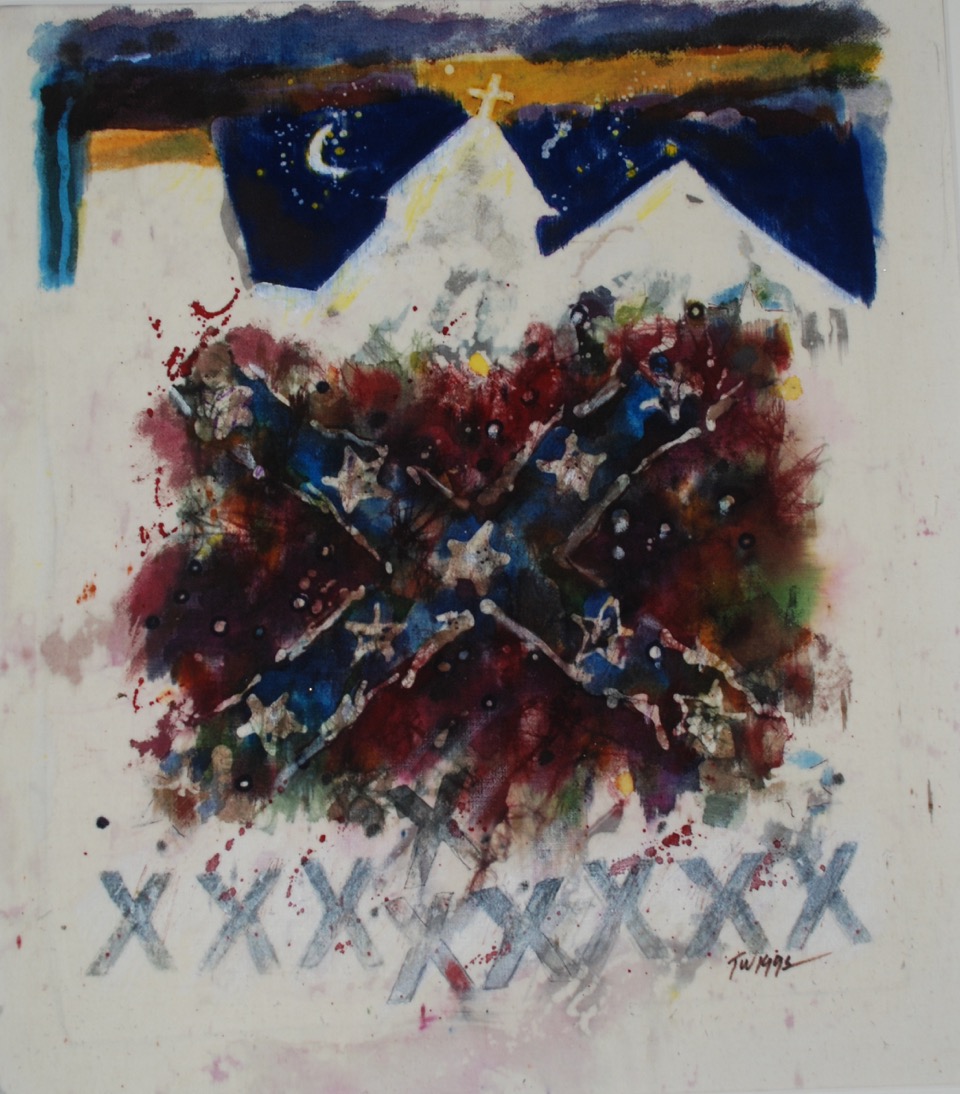Emanuel AME Church massacre inspires haunting new series by Dr. Leo Twiggs

From ArtReport.com
Article by Alison Sher
Dr. Leo Twiggs was one of the first African Americans to earn success as a visual artist in the newly integrated academic landscape of the 1960s. Twiggs paints in batik, a craft that’s so old it’s been found in the tombs of Egypt. He’s the first person to experiment with the method as a painting medium.
Twiggs uses wax, dyes, and muslin cotton fabric to reimagine the often oppressive scenes and symbols that he sees living in the South. His latest series, a nine piece collection, Requiem for Mother Emanuel, is a reflection on the June 2015 shooting at Mother Emanuel Church in Charleston, SC where nine African Americans were murdered during a bible study.
Art Report: What has it been like working as an African American artist since the civil rights movement?
Dr. Leo Twiggs: In the beginning, African American art wasn’t in museums. Then there were shows specifically for African American artists. If you were featured, critics wouldn’t talk about your art. The African American artists, however, were great artists who eventually became accepted into the mainstream. Major museums are now beginning to collect the work of African American artists. They realize that African American art is still American art, and you can’t tell the story of America without including African American artists.
AR: What inspires the themes of your different collections?
LT: I think an artist paints out of his own encounters with the world. I deal with specifics and that’s what makes my work universal. I paint about the struggle of being second class and put in a corner.
When I paint a confederate flag, people don’t know if it’s by a black or white person. People fly that flag like the war is still going on. I wanted to portray it as an old tattered object that I pulled out of a trunk after 150 years.
I also did a series called Targeted Man. I grew up with the KKK in my neighborhood. Being targeted is an experience all African Americans can relate to. When 9/11 happened, everyone in America felt targeted.
AR: How did the Mother Emanuel massacre effect you?
LT: I grew up 45 minutes outside of Charleston. My first art professor was a member of that church. Before doing this series, the last time I went there was for his funeral. I’m doing this series because I have to do it. Something inside me is driving it. I’ve finished four of the nine pieces. They’ve all already sold.
The shooting impacted me because the people were killed in a Bible study, and I know how people are in Bible study because I go each week. You become friends with the people there. I could empathize with what happened with them.
What was amazing was the forgiveness and the redemption of the highest level that was expressed after the shooting. How do I capture the brutality of the event and the forgiveness that followed in nine paintings? You see the brutality in Requiem for Mother Emmanuel #3 (pictured above).
Dylan Roof targeted the oldest church because it’s the oldest African Methodist Episcopal church in the South, and he wanted to make an impact. After that shooting, for a few hours, we came together–not as black and white–as human beings. There was a kind of empathy and unity that came about from that tragedy that we have not seen in this state since the Civil War. But how long does it last? I suspect that it’s fading as we speak. Now that the tragedy is over, the status quo is hardening and legislators are making it even harder to get rid of the Confederate Flag. People sink back into their old ideologies.
That’s why the series is so important for me. I want to capture this moment that people felt redemption from something as horrific as all that, one shining moment that people can treasure that’s dissipating as we speak.
AR: What is the significance of the Confederate Flag in the South to African Americans?
LT: The South is a place of contradictions. You’ve got to read between the lines. You have the hospitality and syrupy sweetness, and you have the racial tensions and the oppressive environment used to keep people in their places. Those are the kinds of contradictions I explore in my work.
I believe that in the South there is a separateness that still exists. People move around each other during the day, but like Martin Luther King Jr. said, on Sunday, the South is the most segregated place in the world. What people don’t see is that there are niceties, but the camaraderie is surface level.
There is a facade that’s here. The Confederate Flag is a facsimile. We’re nice to each other, but in the background there is always a shadow that is the flag and what it represents. Charleston is the place that the Civil War began. That’s one reason why Mother Emmanuel made a powerful statement. In one shining moment, people began to feel the pain of others and the flag came down.
Twiggs does not yet know where the The Requiem for Mother Emmanuel series will be shown when it’s complete. However, like much of Twiggs’ work, the images are already predicted to become iconic portrayals that honor the transcendence of African Americans in response to one of the most significant hate crimes in recent history.



